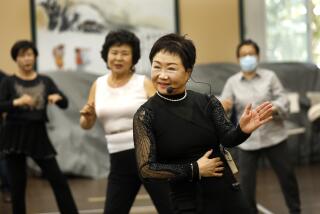MUSIC AND DANCE REVIEWS : Shaman Funeral Rites From Korea
- Share via
From masked dancers and massed rifles among the Dogon of Mali to Dixieland marching bands in our own New Orleans, traditional funerals offer both spectacular entertainment and revealing insights about cultural values.
In Schoenberg Hall, UCLA, on Saturday, the Asia Society’s ongoing Festival of Korea presented the Chindo Sikkim Kut Preservation Group in an 85-minute sampling of shaman funeral rites that can last nine hours on Chindo Island, southwest Korea.
Incorporating song, instrumental music, chant and dance, these rituals of invocation, benediction, purification and leave-taking ended in a spirited drum dance by the group’s director, Pyong-chon Park. However, an earlier sequence provided the evening’s key image: a bolt of white cotton held waist-high and stretching across the stage, presumably from this world to the next.
Over this symbolic pathway, one shaman (always women in Korea) held a bundle containing clothing of the deceased, another the white paper streamers used to contact the dead; a third, a large toy boat. Dressed in white robes and cloth caps, they resembled nuns and nurses--and functioned as both in guiding the deceased away from the living.
Most of the musicians were men in high, wide-brimmed black hats. Playing drums, gong, cymbals, flute, oboe, zither and two-stringed fiddle, they also added their voices to intense choral passages. If the women dancers exuded meticulous control in their stately rising/sinking footwork, delicate flicks of the wrists and subtle shifts in shoulder placement, the musicians supplied great vigor, weight and rhythmic force in their accompaniments.
With everyone seated in a semi-circle framing a table of offerings, this ceremony managed to be at once energetic and mournful, eloquently affirming the joy of living while accepting the inevitability of that long, white road.
More to Read
The biggest entertainment stories
Get our big stories about Hollywood, film, television, music, arts, culture and more right in your inbox as soon as they publish.
You may occasionally receive promotional content from the Los Angeles Times.










